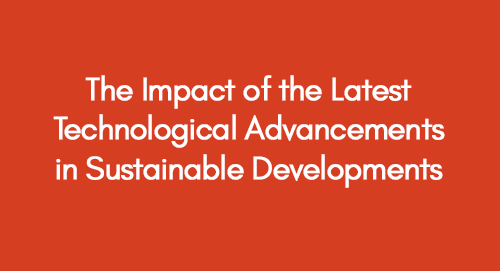
Engineering Production
December 23, 2020
Impact of UK Tourism Industry on Promoting Cultural Heritage and National Economy
December 23, 2020This study explores how recent technological advances are influencing sustainable development efforts, such as renewable energy and eco-friendly practices. It examines how these innovations are shaping a more environmentally responsible and economically sustainable future.
The following text comprises the study's introduction.
Introduction
The construction industry has been largely modified due to the use of the latest software like building information modelling (BIM) and tools like Life Cycle Assessment (LCA) in recent years. The ability of the increased quality of projects, accuracy of scheduling, and reduction in total costs of products in construction projects are some important benefits of the latest technology advancements.
On the other hand, due to the fast depletion of world-building resources and environmental protection issues. The aspect of sustainable construction practices is also rising. There has not been a large number of studies performed o the role of BIM and LCA in sustainable practices of construction in the UK.
Aim of the Research
This proposed research aims to evaluate the impact of the latest technological advancements in sustainable developments; investigating the role of a computer system such as BIM and tools such as LCA in providing support in establishing environmental sustainability in construction projects. The Sheffield UK, area construction projects are selected to conduct this research.
Objectives
The main objectives of the proposed research are as follows:
- To determine the current trends of the utilization of technology solutions in the future development of the sustainable construction industry.
- To investigate the application of BIM and LCA in modern construction practices concerning sustainable designs and features
- To assess the environmental protection issues related to the rapid and mega-scale construction activities in Sheffield, UK and how the awareness of these issues has changed the perceptions of stakeholders.
- To estimate the challenges and difficulties faced by construction companies in incorporating BIM and LCA techniques in sustainable projects to avoid environmental hazards.
- To determine the specific stage and level of BIM and LCA in which they provide the optimal solution to sustainable design development in construction
Context
Sustainability concerns in the field of construction are aimed at developing win-win solutions to manage the clients’’ requirements as well as to adapt to climate changes and resource conservation requirements. The technological advancement in society also demands better environmental protection due to ever high challenges posed to the global environment. In this wake, the role of construction companies is substantial and the construction industry is the largest 8user of Earth materials and minerals (Shen et al., 2010). According to Rockström et al (2013), The base of Earth’s natural resources provision is not infinite, on the other hand, European Commission (2011) stated in the report that due to the rapid functioning of the global and European economy, the pressure on utilization of Earth’s resources keeps on increasing. Also, Yan et al (2010) argued that the transportation, building activities, and manufacturing of construction materials consume large amounts of energy. The studies conducted by OECD (2003) also declare that the construction sector is one of the largest consumers of energy and has drastic impacts on the environment.
Discover the Reasons for the Interest in Environment-Friendly Projects
In this context, the sustainability and environment protection issues become significant for the global and European construction industry. Hence, there is a dire need for the action of the construction sector in the UK as well to show its contribution to the protection of the environment and address the sustainability issues in building projects (Ofori 1992). Another reason for the concentration on sustainable environmentally protected projects is the underlying opportunities of Life Cycle Assessment (LCA) and sustainable procurement to increase the project life. In view of all these factors affecting sustainable construction in the UK, the proposed research will address the following question:
- What are the impacts of the latest technological advancements in sustainable developments of the construction industry, and how do computer-aided systems like BIM and tools like are successful in providing support to establish environmental sustainability in construction projects?
Rationale
One of the recent computer-aided system developments is Building information modelling (BIM) in the construction sector to assist the design, architecture, and building functions. The software provides a virtual building environment that assists in the adaptations and incorporations of new design and construction elements. Though it is a relatively new development, many studies are performed to check its viability in construction projects. Similarly, the use of LCA (life cycle assessment) tools in designing o buildings has proved a remarkable development in project simulations. On the other hand, there are not enough research studies conducted to check the viability of BIM and LCA in building sustainable projects or green buildings (Finnveden and Moberg, 2005). The research is proposed due to the genuine interest of the author in the suitability issues of construction projects and their drastic impacts on the environment. Also, the importance of environmental protection initiatives in the construction industry is a motivation factor for this research. The Sheffield area is selected to conduct this research due to the availability of a large number of new construction projects and increasing awareness of sustainability aspects of environment protection among common people.
This research is intended to identify the potential capabilities of BIM software for sustainable construction practices. Additionally, the increase in population and rise in economic development in European countries and globally put strong pressure on the conservation of material and energy in construction projects. According to Bribian et al (2011), nearly 60% of the total material extracted from the earth is consumed in global building and infrastructure construction projects. Furthermore, the ratio of consumption of this material is very high in developed countries like USA and UK. Hence, this research is viable to explore different opportunities and challenges posed by the use of BIM and LCA systems and tools to design sustainable designs and infrastructure in construction projects.
Literature Review
The literature review section of the proposed research will contain a review of the studies conducted on the role of BIM and LCA in developing sustainable designs and infrastructure in the global construction industry. According to the study of Krygiel and Nies (2008), a BIM computer-aided system comprised of the actual constructions and assemblies’ plans of buildings as compared to the traditional CAD-based building designs. This study is based on the analysis of concerns related to the use of BIM in sustainable construction design practices. Another study by Popov et al. (2008) explained the basic aspects of BIM and considered it as an ability to develop building plan strategies for construction and maintenance. Similarly, Khemlani (2007) proposed the features of BIM utilized in the construction sector as a support to the work process distribution, and basic design modelling, and assisted in designing large projects simultaneously.
Figure out How Life Cycle Assessment (LCA) Assist in Construction
Apart from these studies on the implications of BIM in construction, many studies are also found on Life Cycle Assessment (LCA). According to Finnveden et al (2003), the LCA tool is used to analyse the impacts on the environment and the effective use and disposal of available resources. In another study by Li et al. (2010), the progress in environmental sensitive movements EIA model in construction procedures are primarily based on the methodology of LCA. The EIA model roil is to assist the construction contractors in selecting environmental friendly plans. The other studies by OECD (2003) and EU (2011) also consider the sustainability of materials required in construction processes.
Another aspect to be discussed in the literature review is the implication of sustainability in building practices to increase the efficiencies in economic, social, and ecological areas. Bowyer, (2008) deduced that sustainability in construction is important to minimize wastages and promotes effective usage of energy and materials, persuade recycling and reusability of construction materials, and derive an element of human satisfaction. The ‘Green Building Movement’ is also one of the popular aspects of sustainability in construction processes to support efficient energy, material, and human resource utilization in environmentally friendly ways. Moreover, the study of Lam et al., (2010) demanded the need for environment priority practices in construction to effectively respond the sustainability issues.
Methodology and Research Design
The methodology selected for this proposed research is based on the descriptive framework positivism philosophy. According to Saunders et al (2012), positivism school is the objective and scientific mode of problem-solving that considers factual and logical information flow. On the other, as the problem statement is clearly defined and the premises are selected to perform the research, therefore, a deductive approach will be more suitable to collect the data. The Interpretivism philosophy is not found suitable as it is based on detailed and subjective methods of data collection and analysis.
Research Methods
The survey method is found suitable to collect quantitative data from building contractors, consultants, and project managers on construction sites in Sheffield, UK. The sampling technique is also important to select representative sampling. Due to the unavailability of a total database of construction professionals, a non-probability-based sampling technique, convenience sampling will be used. The proposed sample size is 50 participants for a personally administered survey questionnaire.
The questionnaire will be based on the derived objectives of the research and contains sections on the issues and challenges of sustainable construction practices, and the viability of BIM and LCA tools in assuring sustainability in commercial and residential buildings. The Likert scale will be used to find the opinions on a 5-point scale.
The collected quantitative data will be analysed with the help of SPSS software and the techniques of correlation and regression will be suitable to calculate the relationships of defined variables. These results will be used to answer the raised research questions about the effectiveness of BIM and LCA in designing sustainable buildings. The discussion section will provide a comparison of the calculated results with the findings from the literature review of previous studies in this area.
Anticipated outputs
The expected results of the research are the outlines of specific challenges and applications of BIM and LCA in building projects and the level of their effectiveness in establishing sustainability in real-life construction projects. Also, the research will be able to recommend some strategies to increase the awareness and implication of the latest technology to increase the environmental sensitivity of project designs and building practices in the UK.
Contingency arrangements
The availability of concerned professionals on construction sites and the arrangement of their surveys is an important aspect of the research, Therefore, prior appointments and confirmation of presence on site will be assured before the start of the survey process. Access to the extensive literature review and secondary research data will also be important to arrange proper means beforehand. The use of university library services and internet browsing help needs to be assured in the whole data collection and analysis time. Also, there are chances of data lost from malfunctioning of computer devices; therefore, data backup plans will be important throughout the research period.
Health and Safety Issues and Plan
As the research is intended to collect personally administered survey data, therefore, actual visits to the construction sites will be involved, Therefore, the use of precautionary measures is important to save the author from any injuries.
References
Azhar, S., and Brown, J. (2009). “BIM for Sustainability Analysis.” International Journal of Construction Education and Research, 5: 276-292.
Brian, I.Z.; Capilla, A.V.; Uson, A.A., 2011: Life cycle assessment of building materials: Comparative analysis of energy and environmental impacts and valuation of the eco-efficiency improvement potential. Build Environ 46: 1133-1140
Bernstein, H.; Bowerbank, A., 2008: “Global Green Building Trends: Market Growth and Perspectives.” Around the World. McGraw-Hill Construction; pp. 48.3.
Bowyer, J.L., 2008: The green Movement and the forest products industry. Forest Prod. J. 58(7/8): 6-1
European Commission. 2014. Public Procurement Reform - Factsheet No 8: Social Aspects of the New Rules.
Finnveden G, Nilsson M, Johansson J, Persson Å, Moberg Å, Carlsson T. 2003. Strategic environmental assessment methodologies—applications within the energy sector. Environmental Impact Assessment Review 23 (1): 91-123.
Finnveden G, Moberg Å. 2005. Environmental systems analysis tools – an overview. Journal of Cleaner Production 13 (12): 1165–73.
Hardin, B. (2009). BIM and Construction Management: Proven Tools, Methods, and Workflows. 1sted., Sybex, New York.
Holness, G. (2008). “BIM: Gaining Momentum.” ASHRAE Journal,.6:28 -40
Khemlani, L. (2006). Visual Estimating: Extending BIM into Construction, 21 March 2006. URL:http://www.aecbytes.com/buildingthefuture/2006/VisualEstimating.html
(Accessed 26 Feb 2010).
Khemlani, L. (2007). Top Criteria for BIM Solutions: AECBytes Survey Results , 10 Oct 2007.URL: http://www.aecbytes.com/feature/2007/BIMSurveyReport.html(Accessed 26 Nov 2015)
Krygiel, E. and Nies, B. (2008). Green BIM: Successful Sustainable Design with Building Information Modeling, 1sted., Wiley, New York.
Lam PT, Chan EHW,Chau CK, Poon CS, Chun KP. 2011. Environmentalmanagement system vs green specifications: How do they complement each other in the construction industry? Journal of Environmental Management.92(3): 788-795.
Li Xi, Zhu Y, Zhang Z. 2010. An LCA-Based environmental impact assessment model for construction processes. Building and Environment. 45 (3): 766–75.
Malin, N. (2007). “Building Information Modeling and Green Design.” Environmental Building News, 16(5).
Ofori, G. 1992. The Environment: the fourth construction project objective? Construction Management & Economics .10 (5): 369–95.
Organisation for Economic Co-operation and Development (OECD). 2003. Environmentally Sustainable Buildings: Challenges and Policies. Paris, France: OECD Publications Service.
Popov,V., Mikalauskas, S., Migilinskas, D., and Vainiunas, P., (2006). “Complex Usage of 4D Information Modeling Concept for Building Design, Estimation, Scheduling, and Determination of Effective Variant.
Rockström J, Sachs JD, Öhman MC, Schmidt-Traub G. 2013. Sustainable Development and Planetary Boundaries. Sustainable Development Solutions Network
Sinha, A.; Kutnar, A., 2012. Green Building Rating System – Leadership in Energy and Environmental Design (LEED): Significance for wood industry. LesWood. 64(1/2): 1-5.
Shen L, Tam VWY, Tam L, Ji Y. 2010. Project feasibility study: the key to successful implementation of sustainable and socially responsible construction management practice. Journal of Cleaner Production. 18(3):254-259
Trusty, W.; Horst, S., 2002: Integrating LCA Tools in Green Building Rating Systems. In Environmental Building News (Ed.), The Austin Papers: Best of the 2002 International Green Building Conference (pp. 53–57). Brattleboro VT: BuildingGreen Inc
Tan Y, Shen L, Yao H. 2011. Sustainable construction practice and contractors’competitiveness: a preliminary study. Habitat International 35 (2): 225–230.
Yan H, Shen Q, Fan LCH, Wang Y, Zhang L. 2010. Greenhouse gas emissions in building construction: a case study of One Peking in Hong Kong. Building and Environment. 45 (4): 949–955
Get 3+ Free Dissertation Topics within 24 hours?













